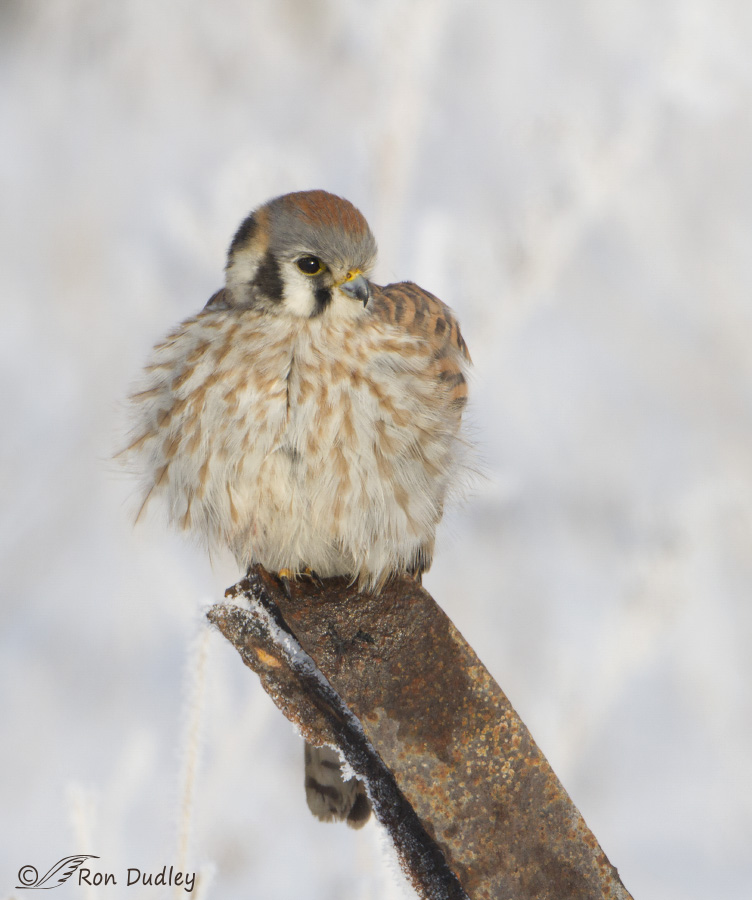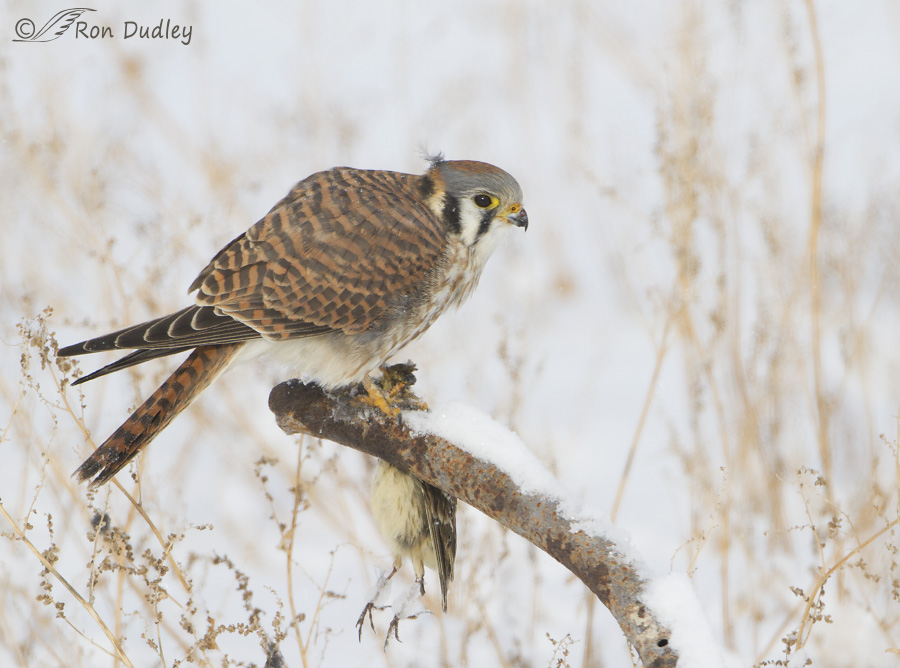Weather like we’re having now is difficult for our avian winter residents and that includes American Kestrels. Salt Lake City received more snow yesterday than we did last year during the months of November, December, January and February combined. And this storm isn’t over yet.

1/1600, f/6.3, ISO 500, Canon 7D, Canon EF 500mm f/4L IS USM + 1.4 tc, not baited, set up or called in
Conditions right now are similar to what we had exactly two years ago today when I photographed this female kestrel at Farmington Bay MBR. There was lots of snow on the ground and it was very cold so as this lovely lady perched on an old rusty piece of metal she was fluffed up to extreme in an effort to keep warm. I’ve posted other images of her in the past and the similar colors of bird and perch always make me think of the title “Rust on Rust”.
She hung around the same area of the refuge for weeks and most of the time she was hunting voles to survive. But finding voles in all that snow wasn’t easy and one time she showed some flexibility in her diet…

1/1600, f/6.3, ISO 500, Canon 7D, Canon EF 500mm f/4L IS USM + 1.4 tc, not baited, set up or called in
when I found her on another nearby piece of rusty metal with a small bird as prey (this image was taken a week prior to the previous one). I believe the prey item may have been an American Pipit. At one point during the meal she dropped the bird into the deep, fluffy snow below but with some difficulty she was able to retrieve it and finish her meal. I was impressed with her tenacity. Incredibly loud (and annoying) airboats launching into the water just a short distance from this spot wouldn’t even phase her.
I love photographing birds in the snow but I wasn’t able to get out during yesterday’s storm because the roads and traffic were a nightmare. I’m hoping for better luck today.
Ron


HI Ron!
I love the bird and in snow, too. Great photo’s! were still in Florida type weather here in Va. I have a low bush white Azellia blooming for almost two weeks now! Also there are Purple Iris out ! Poor plants do not know what to do with almost 80* everyday in late December! Have some good shooting! Sybill
Such magical shots Ron, thanks for sharing!
Charlotte
I just saw one of these beauties (a male I think) while driving back from an appointment. I wanted to turn around to snap a shot with my phone but thought I might scare it off. And it appeared to be hunting so I just traveled on letting the image be a photo in my head.
Beautiful… Makes me sad and worried though…
Yup, it’s a tough and unforgiving world out there.
She is beyond beautiful.
I hope you get enough snow to replenish the water so badly needed. And that it stops at that point.
It will take a heck of a lot of snow to do that, EC – but this is a start.
I’m not at all surprised by this lady’s tenacity. That seems to be their stock in trade. And she is beautiful. Hope you have a good day shooting in the snow. I’m glad to hear that you’re getting a decent amount of it with this storm.
“Hope you have a good day shooting in the snow”
It was absolutely beautiful this morning on the island and at Farmington with all the snow, Susan. Not sure I got any decent bird photos though. I have culling to do…
I’m always impressed with the damage that tiny beak can do…glad you’re seeing Kestrals…hope tis one can find food throughput the winter…allso glad you’re seeing snow…so many areas are in dire need of it …hope you get more, just not on any atea you might have to shovel…
“glad you’re seeing Kestrals”
Patty, I braved the snow this morning for a little shooting and you’ll be happy to hear that I saw (and photographed poorly) a bunch of kestrels at Farmington. More than I’ve seen there for some time.
That’s GREAT news Ron…it’s so scary that they’re struggling in so many areas. I’ve been able to place six nest boxes, two of which were used last year. Need to get more out there! Kestrels ROCK!
Beautiful images, you can keep the snow ( I know y’all depend on snow melt for water). Laura Culley, I enjoyed your informative comment.
Thank you, Jo. I’ll keep all the snow we can get. Up to a reasonable limit of course…
Beautiful Ron (as usual). What a joy it is to enjoy my coffee with your photos/narrative!
It’s always amazed me how birds survive harsh winters, but over the years, I’ve discovered that feathers are really neat things. As a falconer, I hunted ducks with a female redtail hawk during the winter in Wyoming. During the walk back to the Jeep (and much to her dismay, I think), I’d slip the fingers of my bare right hand up underneath her belly feathers because the warmth under there was akin to a blast furnace! That is, unless she’d used the typical redtail Anvil of Death strategy, diving into the creek where the ducks mostly eluded her and her wet feathers froze nearly immediately when I fished her out of the creek. Then, we both bathed in the Jeep’s heater until we arrived home and she could dry off in the living room, but I digress. There are perks to being a falconry bird!
Fast forward to moderating the Cornell Redtail Hawk Cam chat and I learned about how birds stay nice and toasty warm, even when they’re incubating eggs in an ice storm, keeping the eggs nice and toasty warm, too! I highly recommend, “Feathers: The Evolution of a Natural Miracle” by Thor Hanson. He describes the intricate structure involved in the feather construction that makes that happen and writes that we humans cannot replicate that intricacy/detail even in our warmest insulated clothing. The structure traps warmth and/or allows the bird to cool itself, too. Fluffing the feathers allows for maximum heat retention, each dense down feather trapping warm air against the body–and there are roughly a gazillion down feathers under those outside feathers. Trust me on this.
What surprised me is that he also proved that the oils from the uropygial gland do not create the feathers’ water resistance/waterproofing (depending on species). Instead, it’s the structure of the feather against the tension of the water! Gotta admit that idea blew me away, but I digress again. In short, feathers are wondrous things.
But the why part of that they routinely perch on metal is a little beyond my understanding. I would THINK they’d choose the branches of trees instead, that branches would be inherently warmer than metal, but what do I know?
I’m now flying a female Kestrel, a rehab-to-release project, and she’s gone from being considered unable to fly to chasing her first chickadee (with me–I’m sure she’s done that prior to rehab). She didn’t catch it, but she’s flying well and making steady progress! Kestrels are amazing predators, with an attitude that makes them larger than several golden eagles combined!
Overall, birds are wondrous critters!
I really enjoyed your knowledgeable comment, Laura. Thank you.
I remember reading about the discovery that it’s not the uropygial oil that directly creates the waterproofing.
I always used to have my zoology students study feather types and structure. Yes, feathers are marvels of evolution but even they have their limits. I often see severely shivering Barn Owls when it’s very cold and two years ago one of them was rescued along the Antelope Island causeway with a seriously frostbitten face. Thankfully it recovered and was eventually released.
I’ve been following the adventures of your female kestrel (I believe her name is Skye) on your FB posts. Neat stuff!
Thank you so much Laura. I found this fascinating. And a most excellent reminder that our species is not nearly as clever as it thinks.
Ron, I have to admit I was flabbergasted about the uropygial oil not being the water resistant/waterproofing agent. I’d always believed it was the primary function. I mean, that just makes sense, but you learn something new every day! And no, it’s not a perfect system. I would suspect the overall health/condition of the bird plays a role, along with their food (fuel) intake or any other adverse events. If, for example, they get wet, the whole system breaks down and they can freeze to death. Life in The Great Out There ain’t easy.
Elephant’s Child, I gave up on the idea that humans are the top of the food chain–the biggest and best on the planet thing a long time ago. We’re only one species among many with our specific set of strengths and weaknesses. Other species have their set of strengths and weaknesses and we would do well to learn what we can from them all!
Laura, your information about feathers is fascinating. The idea of the feather structure influencing water resistance/waterproofing was of special interest, because when we were in Ecuador a couple of years ago, we learned that Magnificent Frigatebirds, cannot afford to get near the water because they will sink and die. Of course these are birds that we usually flying over water… I also always enjoy your stories about your falconry experiences.
Thanks Susan Stone, I’m glad you’re enjoying them (after 22 years, I’ve got a zillion of them…LOL!) But I’m merely a student here, trying to always learn something new (and fight to keep it in my memory). It is an enormous blessing and privilege to share my life with three raptors right now, all of whom have new and exciting lessons in humility for me every day. This Kestrel has certainly taken my brain for a walkabout and a thorough cleaning over the past couple of months. Evidently, it had gotten all gunked up since I flew the little male Kestrel 14 years ago It’s better now, but not yet performing as rapidly as necessary.
It’s better now, but not yet performing as rapidly as necessary.
Glad you have all that snow. The Great Lake sure deserves it. Not so glad that it prevents you from going outside shooting.
I envy you. No snow here and in six days time the winter is coming. The temperature? º20C/º68F How about that?
That’s the kind of temps we had until just a couple of days ago, Jorge. It can change in a heartbeat!
Beautiful shots Ron, tenacity is the name of the game if one is to survive in the wild.
Thanks for sharing – hope the water problem is better!
“hope the water problem is better”
We still have a long way to go, Dick. Even after this storm (so far) our mountain snowpack is only at 67% of average for this time of year.
It is “rust on rust” and she couldn’t get more fluffed out if she tried.:) Beautiful detail. As much as we appreciate the snow at this time, it does complicate other lives.
In this case I’ll take the “complications” because we need the moisture so badly, Judy. But we’ll see if I’m so cheerful about it when it comes time to shovel more snow…
Always that!
Always a treat Ron viewing your photos! She is a beauty!
I’m glad you enjoyed them, Nancy. Thanks.